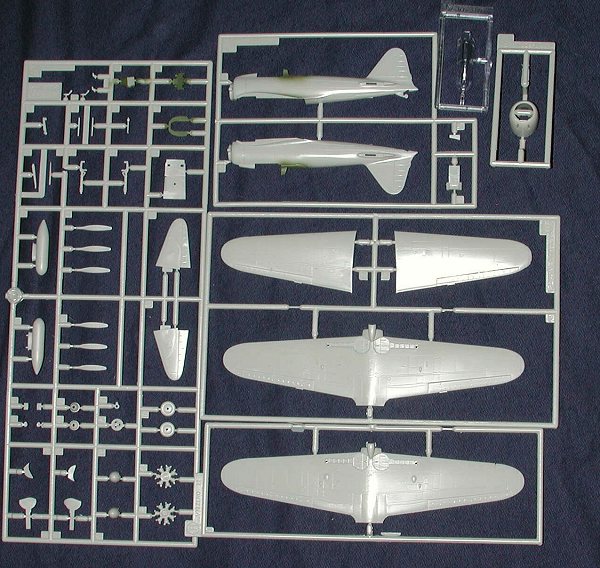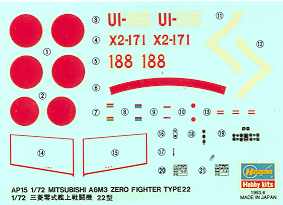
|
KIT: |
Hasegawa 1/72 A6M3 type 22 |
|
KIT # |
51315 (AP 15) |
|
PRICE: |
$12.98 |
|
DECALS: |
Three aircraft |
|
REVIEWER: |
|
|
NOTES: |
Currently (Dec 2002) out of production |

|
HISTORY |
The A6M3 type 22 was actually preceded in production by the clipped wing type 32, often called the Hamp. It was discovered during the Solomons campaign of 1942/43 that the range of the type 32 was inadequate for the long range battles that took place there. This lead Mitsubishi to install 45 liters of fuel in tanks outboard of the guns in the wings. In order to add a bit more range, the folding wing tips of the type 21 were reintroduced. In all other respects, the aircraft was the same as the type 32. A subtype, the 22a had long barrel wing cannon. Production of the type 22 commenced in December of 1942 and approximately half of the production until July 1943 had the longer barreled guns, as did late model 32s. Starting in July, all type 22s were so fitted. Production continued until late 1943 or early 1944 when the type 52 started being produced. There was no type 42.
|
THE KIT |

Now I know that this isn't a new kit. In fact, it is from 1993 if I can believe the side of the box. It is based on the earlier versions of the Zero that Hasegawa started redoing in the late 1980s. Though the old A6M kits from the late 60s were not bad kits, they were getting a bit long in the tooth and Hasegawa wanted to do a new took version. After all, a vast majority of Hasegawa's output is sold locally, and the Zero is probably the most sold type in the country.
If you've built any 1/72 Hasegawa kits in the last decade, then this one will
look most familiar to you. An acceptable cockpit with decals for instruments,
fine engraved panel lines and enough bits and pieces to make sure that you are
doing the proper version. This means that there will be bits left over. As you
can see, the type 22 had a different lower wing from the
 earlier
type 21. Mainly it is in the area of bumps in the lower wing for the cannon and
the difference in trim tabs. The cowling is from the type 32 kit and the rest is
generic A6M. Unlike the kit you'll buy, this one was obtained at a swap meet
where the previous owner had been nice enough to paint the interior bits
Mitsubishi Green.
earlier
type 21. Mainly it is in the area of bumps in the lower wing for the cannon and
the difference in trim tabs. The cowling is from the type 32 kit and the rest is
generic A6M. Unlike the kit you'll buy, this one was obtained at a swap meet
where the previous owner had been nice enough to paint the interior bits
Mitsubishi Green.
Instructions are typically superb as one has come to expect from Hasegawa with colors given in Gunze paints. Decals are for three aircraft; two in green over light grey and the third in overall light grey. We now know that the 'light grey' will actually have to be painted in ame-iro, a caramel color that I used on a 1/48 A6M2 a short time back. The decals are well printed and may actually work if you use very hot water, as that seems to help soften the rather thick decals so they will work a bit better. I actually built one of these schemes when I did my 1/72 Zero collection back about a decade ago. I had no problems with the decals on any of the kits.
|
CONCLUSIONS |
This is a great kit and one that should be on the shelf of every 1/72 model builder. It is odd how the information on colors and camo of the last ten years has made nearly every Zero in my collection obsolete! It could be a conspiracy! :o)
|
REFERENCES |
Mitsubishi A6M Zero, by A.Juszczak, Mushroom Models Publications, 2001
If you would like your product reviewed fairly and quickly by a site that has well over 150,000 visitors a month, please contact me or see other details in the Note to Contributors.